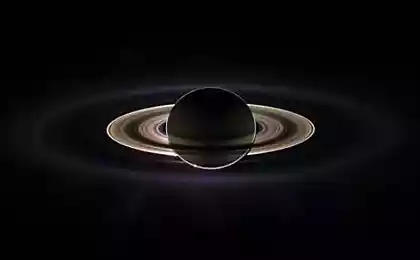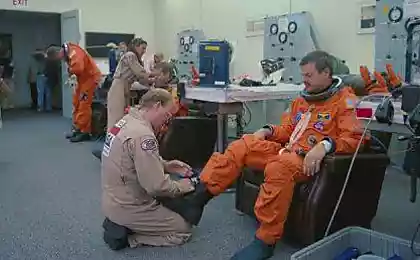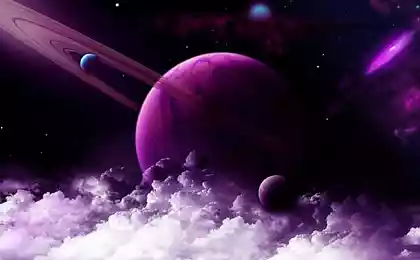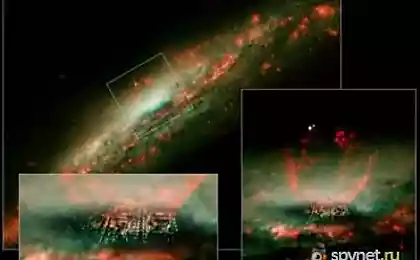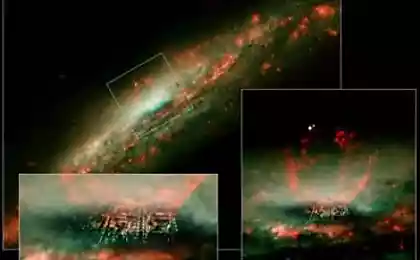269
Incredible facts about space that you probably haven’t heard
The temperature in space, in the orbit of the Earth is +4 ° C
To be exact, it is not in the orbit of the Earth, but at a distance from the Sun equal to the distance of the Earth's orbit. And for an absolutely black body, i.e. one that completely absorbs the sun’s rays without reflecting anything back.
It is believed that the temperature in space tends to absolute zero. Firstly, this is not quite true, since the entire known universe is heated to 3 K, the CMB radiation. The temperature rises near the stars. And we live pretty close to the Sun. Strong thermal protection is needed for space suits and spacecraft because they enter the shadow of the Earth, and our star can no longer warm them to the specified +4 ° C. In the shade, the temperature can drop to -160 ° C, like at night on the moon. It's cold, but it's still a long way from absolute zero.
On Venus in places is lead snow This is probably the most striking fact about the cosmos. Conditions on Venus are so different from anything we might imagine that Venus could safely fly to earthly hell to rest in mild climates and comfortable conditions. Therefore, as fantastic as the phrase “lead snow” may seem, for Venus, it is a reality.
Thanks to the radar of the American Magellan probe in the early 90s, scientists found a coating on the tops of the Venusian mountains that has a high reflectivity in the radio band. Initially, several versions were assumed: the consequence of erosion, the deposition of iron-containing materials, etc. Later, after several experiments on Earth, they came to the conclusion that this is the most natural metallic snow, consisting of bismuth sulfides and lead. In a gaseous state, they are released into the atmosphere of the planet during volcanic eruptions. Then thermodynamic conditions at an altitude of 2600 m contribute to condensation of compounds and fall on elevations.
There are 13 planets in the solar system or more.
When Pluto was demoted from the planets, the rule of good tone was the knowledge that there are only eight planets in the solar system. However, at the same time, a new category of celestial bodies was introduced - dwarf planets. These “subplanets” that have a rounded (or close) shape, are no one’s satellites, but, at the same time, can not clear their own orbit from less massive competitors. Today it is believed that there are five such planets: Ceres, Pluto, Hanumea, Eris and Makemake. The closest to us is Ceres. A year from now, we'll know more about it than we do now, thanks to the Dawn probe. So far we only know that it is covered with ice and from two points on the surface it evaporates water at a rate of 6 liters per second. Pluto will be announced next year by New Horizons. In general, as 2014 in space will be the year of comets, 2015 promises to be the year of dwarf planets.
The rest of the dwarf planets are beyond Pluto, and we will not know any details about them soon. Just recently, another candidate was found, although officially he was not included in the list of dwarf planets, as well as his neighbor Sedna. But it is possible that they will find more, several larger dwarfs, so the number of planets in the solar system will increase.
Hubble Telescope is not the most powerful
Thanks to the huge volume of images and impressive discoveries made by the Hubble telescope, many people have the idea that this telescope has the highest resolution and is able to see details that can not be seen from Earth. For a while, that was true: despite the fact that on Earth you can collect large mirrors on telescopes, a significant distortion in the images is introduced by the atmosphere. Therefore, even a “modest” mirror with a diameter of 2.4 meters in space, allows you to achieve impressive results.
However, over the years since the launch of Hubble and terrestrial astronomy did not stand still, several technologies have been developed that allow, if not completely get rid of the distorting effect of air, then significantly reduce its impact. Today, the most impressive resolution is the Very Large Telescope of the European Southern Observatory in Chile. In the optical interferometer mode, when four main and four auxiliary telescopes are working together, it is possible to achieve a resolution about fifty times higher than Hubble’s.
For example, if Hubble gives a resolution on the moon of about 100 meters per pixel (hello to anyone who thinks that you can consider this Apollo landers), then the VLT can distinguish details up to 2 meters. That is, in its resolution, American landers or our lunar rovers would look like 1-2 pixels (but they will not watch because of the extremely high cost of working time).
A pair of Keck telescopes, in interferometer mode, can exceed the resolution of Hubble ten times. Even individually, each of the ten-meter Keck telescopes, using adaptive optics technology, is able to surpass Hubble's application by twice. For example, a photo of Uranus:
However, Hubble is not left without work, the sky is large, and the breadth of coverage of the space telescope camera exceeds ground capabilities. Relict radiation (Latin relictum – residue), cosmic microwave background radiation is cosmic electromagnetic radiation with a high degree of isotropy and with a spectrum characteristic of a completely black body with a temperature of 2.72548 ± 0.00057 K.
Source: /users/1108
To be exact, it is not in the orbit of the Earth, but at a distance from the Sun equal to the distance of the Earth's orbit. And for an absolutely black body, i.e. one that completely absorbs the sun’s rays without reflecting anything back.
It is believed that the temperature in space tends to absolute zero. Firstly, this is not quite true, since the entire known universe is heated to 3 K, the CMB radiation. The temperature rises near the stars. And we live pretty close to the Sun. Strong thermal protection is needed for space suits and spacecraft because they enter the shadow of the Earth, and our star can no longer warm them to the specified +4 ° C. In the shade, the temperature can drop to -160 ° C, like at night on the moon. It's cold, but it's still a long way from absolute zero.
On Venus in places is lead snow This is probably the most striking fact about the cosmos. Conditions on Venus are so different from anything we might imagine that Venus could safely fly to earthly hell to rest in mild climates and comfortable conditions. Therefore, as fantastic as the phrase “lead snow” may seem, for Venus, it is a reality.
Thanks to the radar of the American Magellan probe in the early 90s, scientists found a coating on the tops of the Venusian mountains that has a high reflectivity in the radio band. Initially, several versions were assumed: the consequence of erosion, the deposition of iron-containing materials, etc. Later, after several experiments on Earth, they came to the conclusion that this is the most natural metallic snow, consisting of bismuth sulfides and lead. In a gaseous state, they are released into the atmosphere of the planet during volcanic eruptions. Then thermodynamic conditions at an altitude of 2600 m contribute to condensation of compounds and fall on elevations.
There are 13 planets in the solar system or more.
When Pluto was demoted from the planets, the rule of good tone was the knowledge that there are only eight planets in the solar system. However, at the same time, a new category of celestial bodies was introduced - dwarf planets. These “subplanets” that have a rounded (or close) shape, are no one’s satellites, but, at the same time, can not clear their own orbit from less massive competitors. Today it is believed that there are five such planets: Ceres, Pluto, Hanumea, Eris and Makemake. The closest to us is Ceres. A year from now, we'll know more about it than we do now, thanks to the Dawn probe. So far we only know that it is covered with ice and from two points on the surface it evaporates water at a rate of 6 liters per second. Pluto will be announced next year by New Horizons. In general, as 2014 in space will be the year of comets, 2015 promises to be the year of dwarf planets.
The rest of the dwarf planets are beyond Pluto, and we will not know any details about them soon. Just recently, another candidate was found, although officially he was not included in the list of dwarf planets, as well as his neighbor Sedna. But it is possible that they will find more, several larger dwarfs, so the number of planets in the solar system will increase.
Hubble Telescope is not the most powerful
Thanks to the huge volume of images and impressive discoveries made by the Hubble telescope, many people have the idea that this telescope has the highest resolution and is able to see details that can not be seen from Earth. For a while, that was true: despite the fact that on Earth you can collect large mirrors on telescopes, a significant distortion in the images is introduced by the atmosphere. Therefore, even a “modest” mirror with a diameter of 2.4 meters in space, allows you to achieve impressive results.
However, over the years since the launch of Hubble and terrestrial astronomy did not stand still, several technologies have been developed that allow, if not completely get rid of the distorting effect of air, then significantly reduce its impact. Today, the most impressive resolution is the Very Large Telescope of the European Southern Observatory in Chile. In the optical interferometer mode, when four main and four auxiliary telescopes are working together, it is possible to achieve a resolution about fifty times higher than Hubble’s.
For example, if Hubble gives a resolution on the moon of about 100 meters per pixel (hello to anyone who thinks that you can consider this Apollo landers), then the VLT can distinguish details up to 2 meters. That is, in its resolution, American landers or our lunar rovers would look like 1-2 pixels (but they will not watch because of the extremely high cost of working time).
A pair of Keck telescopes, in interferometer mode, can exceed the resolution of Hubble ten times. Even individually, each of the ten-meter Keck telescopes, using adaptive optics technology, is able to surpass Hubble's application by twice. For example, a photo of Uranus:
However, Hubble is not left without work, the sky is large, and the breadth of coverage of the space telescope camera exceeds ground capabilities. Relict radiation (Latin relictum – residue), cosmic microwave background radiation is cosmic electromagnetic radiation with a high degree of isotropy and with a spectrum characteristic of a completely black body with a temperature of 2.72548 ± 0.00057 K.
Source: /users/1108








